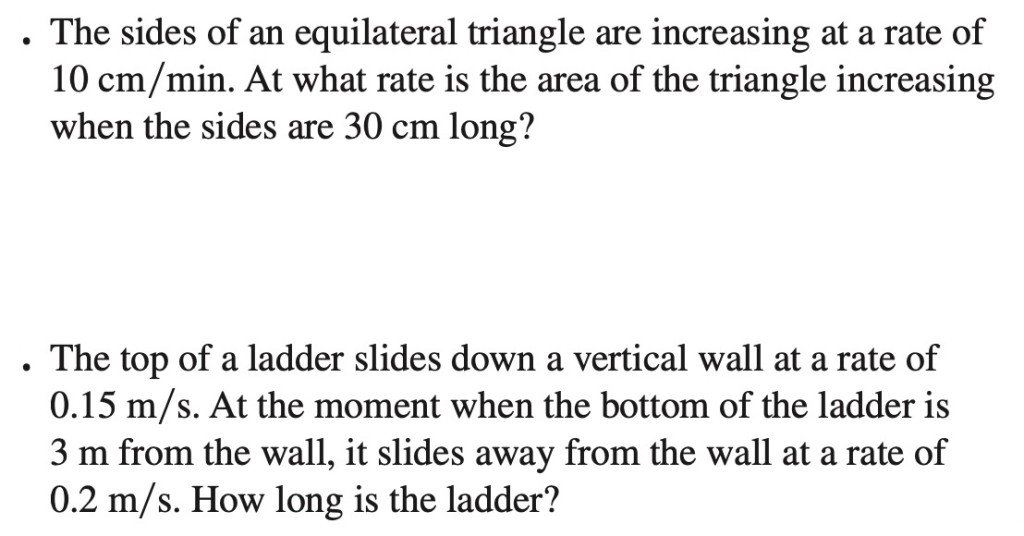Solutions to Stewart Calculus 8th edition
Answer
These are related rates questions.
For the first one let $a$ be the side of the equilateral triangle. Then its area is $$ S = \frac{1}{2}\,a\times \frac{\sqrt 3 a}{2}=\frac{\sqrt 3}{4}a^2$$ because the altitude of an equlateral triangle has length $\frac{\sqrt 3 a}{2}$. Now we want to know $\frac{dS}{dt}$ when $a=30$ and $\frac{da}{dt}=10$. We have $$\frac{dS}{dt}=\frac{d}{dt}\Big( \frac{\sqrt 3}{4}a^2 \Big) = \frac{\sqrt 3}{4}\, \frac{d}{dt}a^2 = \frac{\sqrt 3}{4}\, 2a\frac{da}{dt}=\frac{\sqrt 3}{4}\,600=150\sqrt 3\quad \textrm{cm}^2/\textrm{min}$$
For the second question, let $y$ be the distance between the top of the ladder and the ground, and $x$ be the distance between the bottom of the ladder and the wall. Let $h$ be the length of the ladder. Then by Pythagorean theorem we have $$h^2=x^2 +y^2 $$ We know that $\frac{dy}{dt}=-0.15$ m/s (the minus sign is because the ladder is falling and therefore $y$ is decreasing) and $\frac{dx}{dt} = 0.2$ m/s when $x=3$ m. Note that the sign of $\frac{dx}{dt}$ is positive since the bottom of the ladder is moving away from the wall and therefore $x$ is increasing. Now by differentiating the above formula we get $$ 2h\frac{dh}{dt} =\frac{d}{dt}(h^2)= \frac{d}{dt} (x^2 +y^2 ) =2x \frac{dx}{dt} + 2y \frac{dy}{dt} = 2\times 3\times0.2 +2y(-0.15)$$ However, note that $\frac{dh}{dt}=0$ because the size of the ladder does not change! So $$ 0= 2\times 3\times0.2 +2y(-0.15) \implies y=4 \; \textrm {m}$$ Thus the length of the ladder is $$h^2=x^2 +y^2 =9+16=25 \implies h=5 \; \textrm {m}$$
- accepted
- 2651 views
- $25.00
Related Questions
- Banach fixed-point theorem and the map $Tf(x)=\int_0^x f(s)ds $ on $C[0,1]$
- Integral of trig functions
- Compute $\lim_{x \rightarrow 0} \frac{1-\arctan (\sin(x)+1)}{e^{x}-1}$
- (a) Find the coordinates (x,y) which will make the rectangular area A = xy a maximum. (b) What is the value of the maximum area?
- Find amplitude-frequency characteristic of a discrete finite signal using Z-transform
- Hs level math (problem solving) *der
- Second order directional derivative
- Does $\lim_{(x,y)\rightarrow (0,0)}\frac{(x^2-y^2) \cos (x+y)}{x^2+y^2}$ exists?


